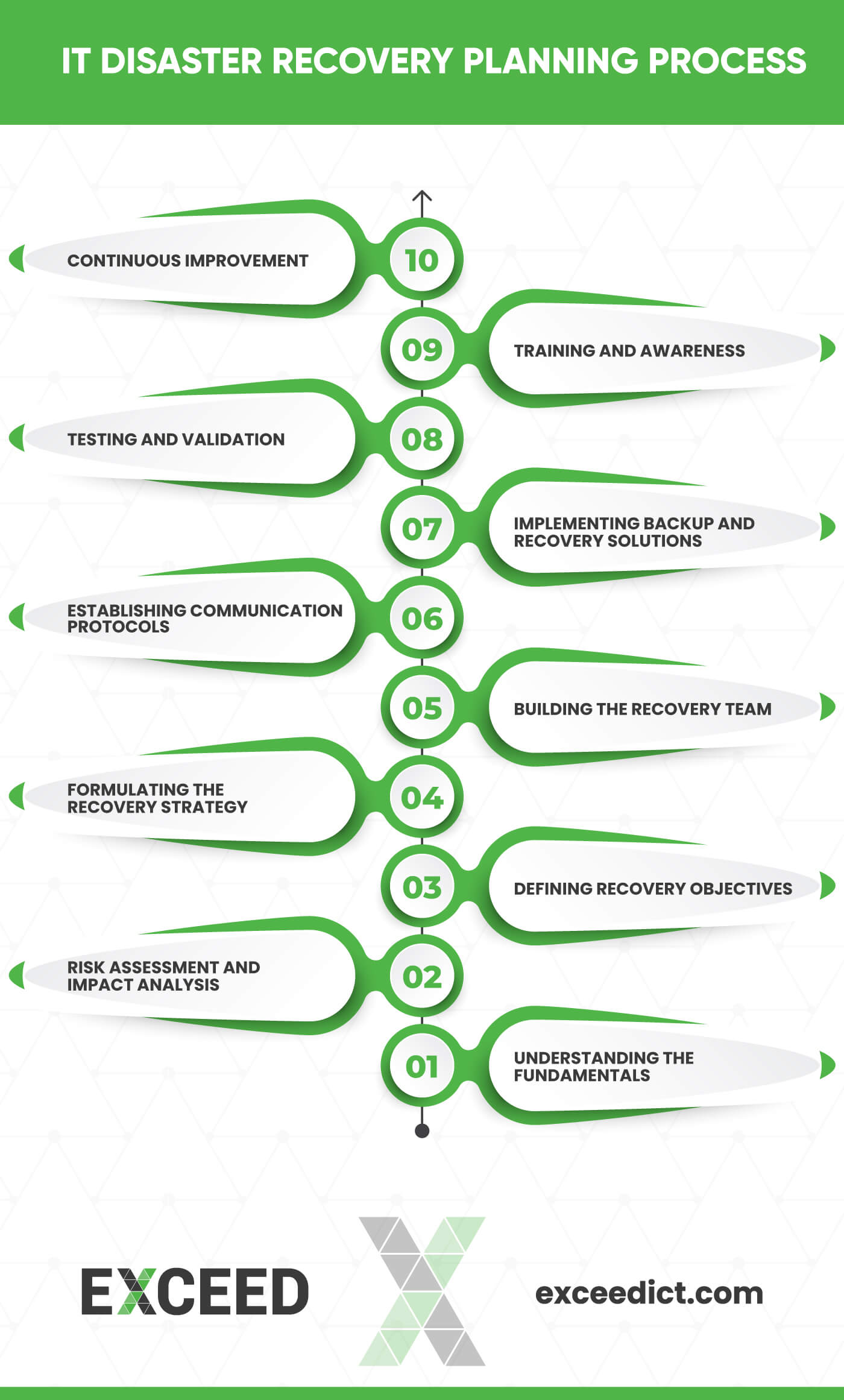
IT Disaster Recovery Planning Process
 In today’s fast-paced digital landscape, where businesses rely heavily on technology, having a robust IT disaster recovery planning process is imperative.
In today’s fast-paced digital landscape, where businesses rely heavily on technology, having a robust IT disaster recovery planning process is imperative.
Disruptions can arise from various sources, including cyberattacks, hardware failures, natural disasters, and human errors.
This article delves into the intricacies of the IT disaster recovery planning process, guiding you through a step-by-step approach to ensure your organisation’s operational continuity even in the face of adversity.
IT Disaster Recovery Planning Process: A Holistic Approach
 Understanding the Fundamentals
Understanding the Fundamentals
To kickstart the IT disaster recovery planning process, it’s essential to develop a deep understanding of your organisation’s technological landscape. This involves cataloguing all critical systems, applications, and data repositories.
Risk Assessment and Impact Analysis
Identify potential risks and assess their potential impact on your business operations. Consider various scenarios, from data breaches to infrastructure failures. This analysis informs your recovery strategy.
Defining Recovery Objectives
Set clear recovery time objectives (RTO) and recovery point objectives (RPO) for each critical system. RTO determines how quickly systems should be restored, while RPO specifies the acceptable data loss.
Formulating the Recovery Strategy
Based on the risk assessment and objectives, devise a comprehensive recovery strategy. This includes outlining backup mechanisms, data replication plans, and alternative infrastructure options.
Building the Recovery Team
Assemble a dedicated recovery team with well-defined roles and responsibilities. Effective communication and coordination are vital during the recovery process.
Establishing Communication Protocols
Develop communication protocols to ensure seamless interaction among team members, stakeholders, and external partners during the recovery phase.
Implementing Backup and Recovery Solutions
Deploy robust backup solutions that align with your recovery objectives. Leverage incremental backups, off-site storage, and cloud-based solutions for enhanced resilience.
Testing and Validation
Regularly test the recovery plan through simulated scenarios. This helps identify gaps, refine processes, and ensure the plan’s effectiveness.
Training and Awareness
Educate employees about their roles during a disaster and conduct training sessions to enhance their awareness of recovery procedures.
Continuous Improvement
Regularly review and update the IT disaster recovery planning process. Adapt to technological advancements and evolving business needs.
Frequently Asked Questions
What is the role of risk assessment in the IT disaster recovery planning process?
Risk assessment plays a pivotal role as it helps identify potential threats and vulnerabilities, allowing organisations to prioritise resources and plan effective countermeasures.
How frequently should the IT disaster recovery plan be tested?
It’s recommended to test the plan at least annually, or whenever significant changes are made to the IT infrastructure. Regular testing ensures the plan’s reliability.
Can cloud-based solutions enhance IT disaster recovery?
Yes, cloud-based solutions offer scalability, remote accessibility, and automated backups, making them valuable components of a comprehensive disaster recovery strategy.
What is the significance of defining RTO and RPO?
Recovery Time Objective (RTO) specifies the acceptable downtime, while Recovery Point Objective (RPO) defines the maximum acceptable data loss. These metrics guide the recovery process.
How does employee training contribute to the recovery process?
Employee training ensures that everyone understands their roles and responsibilities during a disaster, enabling a coordinated and efficient response.
Is the IT disaster recovery planning process a one-time effort?
No, the process requires ongoing attention. Technology evolves, and so do business needs. Regular updates and adjustments are essential to maintain the plan’s effectiveness.
Conclusion
The IT disaster recovery planning process is not a mere formality; it’s a strategic imperative for modern businesses. By following the comprehensive approach outlined in this article, organisations can proactively mitigate risks, minimise downtime, and safeguard their operations. Remember, a well-prepared business is a resilient business.
You may also like to know more about
- Disaster Recovery Plan For Ensuring Business Continuity in Challenging Times.
- Business Continuity Planning vs Disaster Recovery Planning.
- Step by Step Guide for a business continuity plan.
- What is Business Continuity Planning? Importance, Risk Assessment, & Core Objectives.
- Understanding the Disaster Recovery Planning – steps, benefits and best practices.
- Disaster Recovery Planning To Ensure The Connectivity in Crisis.
Stay connected with EXCEED ICT
Stay connected with EXCEED ICT by joining our social networks (given at footer). Get the latest updates, news, and tips for enterprise device deployment. Follow us on Twitter, Facebook, and LinkedIn for the best enterprise device deployment solutions.
Help us to improve our enterprise by rating us on Google Maps. Your feedback and comments are valuable to us and will be used to make our services even better.



